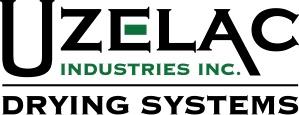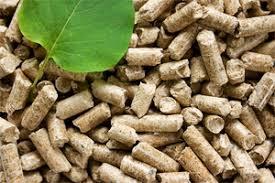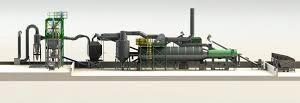 Application of Uzelac Manure Drying Systems.
Application of Uzelac Manure Drying Systems.
Uzelac Industries based in Greendale, WI. has developed considerable expertise in the design and installation of rotary drum dryers capable of reducing the moisture content of manure from high-rise houses with 65 percent water or belt systems with 45 percent water down to 15 percent. Manure handling and drying installations convert a waste product into a valuable pathogen-free fertilizer in a commercially acceptable form for domestic and institutional applications.
Direct application of raw manure to farmland will be subject to increasing restriction as nitrogen percolating through soil contaminates ground water and hence wells. Runoff entering streams and waterways will come under heightened scrutiny from state and federal regulators.

A Uzelac rotary dryer installations reduces odor, obviating complaints and lawsuits and when used with belt manure collection, effectively eliminates fly problems without expenditure on insecticides. In the future environmental regulations may necessitate on-farm or remote processing of manure before application.
A typical Uzelac on-farm or remote installation comprises:-
- Hoppers to accumulate raw material conveyed from houses or delivered from farms
- A mixer to ensure that raw material is uniform in composition before processing
- An air-heater assembly to fire the rotary drum dryer configured to the volume of input
- A product collector to receive processed, dried material
- A dust cyclone to limit air contamination
- An optional pellet mill and pellet cooler to convert processed material into a saleable form
- Packaging systems for either pelleted or granular products or a storage and delivery system for bulk product
Current Uzelac customers in the U.S. poultry industry include Herbruck’s Poultry Ranch, Giroux’s Poultry Farm, Michael Foods, Foster Farms and Tyson Foods among others.
Financial Evaluation of Uzelac Manure Drying Installations
Calculating the return from an investment in a manure drying installation is dependent on a number of factors including:-
- Housing system such as high-rise, belt battery or aviary that will influence the moisture content of raw manure.
- Prevailing power, gas and labor costs.
- Single or two-shift operation to process manure from a complex or combination of smaller operations.
- Seasonal climatic conditions with hot weather increasing water consumption of a flock, leading to manure with a higher moisture content
- Size of supply flock influencing initial capital cost and utilization. Some installations are sited remotely to receive manure from a number of farms or complexes.
- Form of product sold, whether bulk or bagged, granular or pelleted, will determine unit revenue.
- State or local grants to offset capital cost.
- Prevailing interest rates.
In order to calculate the return on investment from a manure-drying installation the following boiler-plate examples are provided. The first model assumes single shift operation, 40 hours/week; processing manure from one million hens in aviaries. The format allows insertion of specific values relating to a complex:-

Capital cost of a Uzelac manure drying installation.
|
Buildings and installations
|
$1,060,000 |
|
Mechanical equipment
|
$2,945,000 |
|
Total Capital cost
|
$4,005,000 |
|
Annual Fixed Cost of Operation :
|
|
Depreciation, Buildings @ 7% pa
|
$ 74,200 |
|
Depreciation, Equipment @ 15% pa
|
$ 441,750 |
|
Interest on capital @ 3% pa
|
$ 120,150 |
|
Overhead provision
|
$ 10,000 |
|
Annual Fixed Cost
|
$ 646,100 |
|
Annual Variable Cost of Single-shift Operation
|
|
Labor
|
$ 150,000 |
|
Maintenance provision
|
$ 50,000 |
|
Power Estimate
|
$ 250,000 |
|
Annual Variable Cost
|
$ 450,000 |
|
Annual Cost of Operation
|
$1,096,100 |
In assessing the return on investment it is assumed that 1,000,000 hens in aviary houses produce 35,000 tons raw manure each year with 45 percent moisture content dried to 15 percent resulting in 24,500 tons of saleable product.
|
Revenue from dry product @ $145 per ton
|
$3,552,500 |
|
Less value of wet manure @ $10 per ton
|
$ 350,000 |
|
Differential in revenue
|
$ 3,202,500 |
|
Add saving on fly and rodent control
|
$ 10,000 |
|
Annual Revenue
|
$ 3,212,500 |
|
Less Annual Fixed and Variable Costs
|
$ 1,096,100 |
|
Annual Contribution
|
$ 2,116,400 |
Discounted Cash Flow Calculation
In order to evaluate the capital cost of the manure drying installation the annual contribution over a five-year period would be:-
| Year |
1 |
2 |
3 |
4 |
5 |
|
5% discount factor
|
0.95 |
0.91 |
0.86 |
0.82 |
0.78 |
|
Annual Revenue ($ mil.)
|
2.01 |
1.93 |
1.82 |
1.74 |
1.65 |
Net Present value over 5 years attains $9.15 million
This exceeds Present Value applying 5% annual discount factor
Discounted payback of 25 months
In evaluating the effect of selling price as the major variable influencing ROI a series of DCF calculations were performed yielding the following results:-
Selling Price per ton Net present Value of Investment over 5 years
| $ 75 |
$1.74 million |
| $ 85 |
$2.79 million |
| $105 |
$4.91 million |
| $125 |
$7.03 million |
| $145 |
$9.15 million |
The return on investment is extremely sensitive to unit selling price. At $105 per ton the project would require 47 months to achieve a breakeven net present value of $4 million, corresponding to the original capital investment.
In demonstrating the influence of volume and price on the return on investment the manure-drying installation was evaluated with the theoretical output of 2 million hens, operating the Uzelac plant on a double-shift schedule 80 hours per week, corresponding to five, 16-hour working days. In this approach in the interests of simplicity, fixed costs of $646,100 would remain unaltered but variable costs would double to $900,000.
Annual Cost of Operation $1,546,100
In assessing the return on investment it is assumed that 2,000,000 hens produce
70,000 tons wet manure each year at 45 percent moisture content dried to 15 percent resulting in
49,000 tons of saleable product.
| Revenue from dry product @ $145 per ton |
$7,105,000 |
| Less value of wet manure @ $10 per ton |
$ 700,000 |
| Differential in revenue |
$ 6,405,000 |
| Add saving on fly and rodent control |
$ 20,000 |
| Annual Revenue |
$ 6,425,000 |
| Less Annual Fixed and Variable Costs |
$ 1,546,100 |
| Annual Contribution |
$ 4,878,900 |
Discounted Cash Flow Calculation
In order to evaluate the capital cost of the manure drying installation the annual contribution over a five-year period would be:-
| Year |
1 |
2 |
3 |
4 |
5 |
| 5% discount |
0.95 |
0.91 |
0.86 |
0.82 |
0.78 |
| Annual Revenue ($ mil) 4.63 4.44 4.20 4.00 3.81 |
Net Present value over 5 years attains $21.08 million
Exceeds Present Value by a factor of 5 applying a 5% annual discount factor
Discounted payback period of 10 months
In evaluating the effect of selling price as the major variable influencing return, a series of DCF calculations were performed yielding the following results:-
Selling Price per ton Net present Value of Investment over 5 years
| $ 75 |
$ 6.27 million |
| $ 85 |
$ 8.37 million |
| $105 |
$12.61 million |
| $125 |
$16.84 million |
| $145 |
$21.08 million |
The return on investment is extremely sensitive to unit selling price. At $75 per ton the project would require 37 months to achieve a breakeven net present value of $4 million, corresponding to the original capital investment.
The calculations provided assume manure from an aviary house with 45 percent moisture. Manure from high-rise complexes with moisture content of 65 percent would require a higher drying capacity with proportional increases in capital and operating costs to reduce moisture content to 15 percent.
Uzelac manufactures components for rotary drying systems that can be adapted in capacity and layout to suit specific applications. Uzelac engineers are available to review specifications and to design custom installations.
Additional information on Uzelac installations can be accessed by clicking on to the Uzelac logo on the right side of the welcome page or on www.uzelacind.com or (414) 529 0240 - contact Mike Terry.